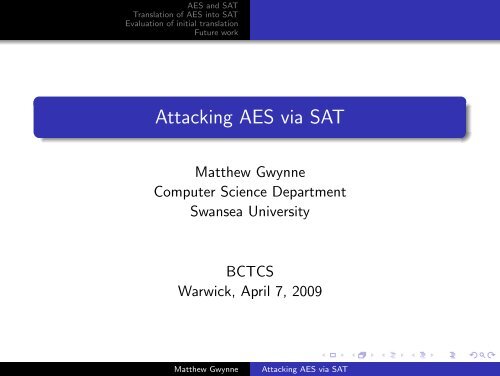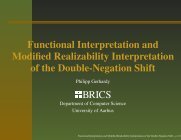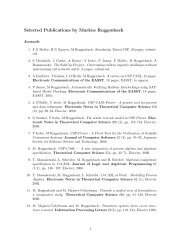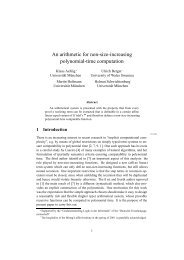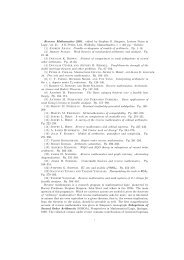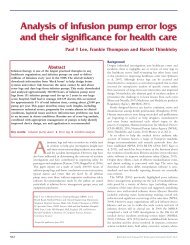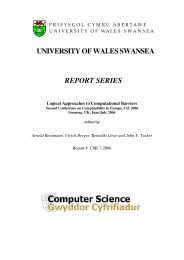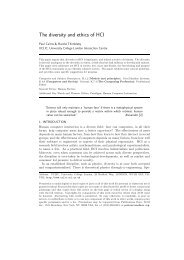Attacking AES via SAT - Department of Computer Science
Attacking AES via SAT - Department of Computer Science
Attacking AES via SAT - Department of Computer Science
You also want an ePaper? Increase the reach of your titles
YUMPU automatically turns print PDFs into web optimized ePapers that Google loves.
<strong>AES</strong> and <strong>SAT</strong><br />
Translation <strong>of</strong> <strong>AES</strong> into <strong>SAT</strong><br />
Evaluation <strong>of</strong> initial translation<br />
Future work<br />
<strong>Attacking</strong> <strong>AES</strong> <strong>via</strong> <strong>SAT</strong><br />
Matthew Gwynne<br />
<strong>Computer</strong> <strong>Science</strong> <strong>Department</strong><br />
Swansea University<br />
BCTCS<br />
Warwick, April 7, 2009<br />
Matthew Gwynne<br />
<strong>Attacking</strong> <strong>AES</strong> <strong>via</strong> <strong>SAT</strong>
Introduction<br />
<strong>AES</strong> and <strong>SAT</strong><br />
Translation <strong>of</strong> <strong>AES</strong> into <strong>SAT</strong><br />
Evaluation <strong>of</strong> initial translation<br />
Future work<br />
In the following talk, a general translation framework, based<br />
around <strong>SAT</strong>, is considered, with the aim <strong>of</strong> providing a platform for<br />
research into the properties <strong>of</strong> a variety <strong>of</strong> cryptographic ciphers<br />
and other problems.<br />
In this case the Advanced Encryption Standard (<strong>AES</strong>) is<br />
considered, which has had a lot <strong>of</strong> interest from other research<br />
areas, centring around either it’s algebraic structure or purely<br />
around it’s cryptographic structure. This appears to be the first<br />
treatment <strong>of</strong> this cipher using <strong>SAT</strong> as a basis.<br />
Matthew Gwynne<br />
<strong>Attacking</strong> <strong>AES</strong> <strong>via</strong> <strong>SAT</strong>
Basic idea<br />
<strong>AES</strong> and <strong>SAT</strong><br />
Translation <strong>of</strong> <strong>AES</strong> into <strong>SAT</strong><br />
Evaluation <strong>of</strong> initial translation<br />
Future work<br />
Encryption/Decryption<br />
P<br />
K<br />
−−−−−−−→<br />
Encryption<br />
C =⇒ C<br />
K<br />
−−−−−−−→<br />
Decryption<br />
P<br />
The notion <strong>of</strong> “breaking” used in this presentation, is that given a<br />
single plaintext and single block <strong>of</strong> ciphertext, can one deduce a<br />
key. To find unique keys, given multiple plaintext, ciphertext pairs,<br />
this could then be generalised.<br />
Matthew Gwynne<br />
<strong>Attacking</strong> <strong>AES</strong> <strong>via</strong> <strong>SAT</strong>
Overview<br />
<strong>AES</strong> and <strong>SAT</strong><br />
Translation <strong>of</strong> <strong>AES</strong> into <strong>SAT</strong><br />
Evaluation <strong>of</strong> initial translation<br />
Future work<br />
1 <strong>AES</strong> and <strong>SAT</strong><br />
2 Translation <strong>of</strong> <strong>AES</strong> into <strong>SAT</strong><br />
3 Evaluation <strong>of</strong> initial translation<br />
4 Future work<br />
Matthew Gwynne<br />
<strong>Attacking</strong> <strong>AES</strong> <strong>via</strong> <strong>SAT</strong>
<strong>AES</strong> and <strong>SAT</strong><br />
Translation <strong>of</strong> <strong>AES</strong> into <strong>SAT</strong><br />
Evaluation <strong>of</strong> initial translation<br />
Future work<br />
<strong>AES</strong> and <strong>SAT</strong><br />
Matthew Gwynne<br />
<strong>Attacking</strong> <strong>AES</strong> <strong>via</strong> <strong>SAT</strong>
Why <strong>SAT</strong>?<br />
<strong>AES</strong> and <strong>SAT</strong><br />
Translation <strong>of</strong> <strong>AES</strong> into <strong>SAT</strong><br />
Evaluation <strong>of</strong> initial translation<br />
Future work<br />
<strong>AES</strong> has been approached using other methods such as:<br />
1 Algebraic methods using both Gröbner bases.<br />
2 Algebraic methods using sparse equation systems.<br />
<strong>SAT</strong> is especially attractive here as it has had a lot <strong>of</strong> success in<br />
the past 10 years, for example:<br />
1 Finding the van der Waerden number vdw 2 (6, 6) = 1132.<br />
2 Solving a variety <strong>of</strong> scheduling and modelling problems<br />
including the verification <strong>of</strong> train signalling systems.<br />
Such successes highlight <strong>SAT</strong> as a strong and interesting method<br />
and provide additional motivation for it’s use in studying <strong>AES</strong>. See<br />
the recent Handbook <strong>of</strong> Satisfiability.<br />
Matthew Gwynne<br />
<strong>Attacking</strong> <strong>AES</strong> <strong>via</strong> <strong>SAT</strong>
<strong>SAT</strong><br />
<strong>AES</strong> and <strong>SAT</strong><br />
Translation <strong>of</strong> <strong>AES</strong> into <strong>SAT</strong><br />
Evaluation <strong>of</strong> initial translation<br />
Future work<br />
Boolean Satisfiability is the problem, given a propositional formula<br />
F , <strong>of</strong> finding an assignment ϕ : var(F ) → {0, 1} such that<br />
ϕ(F ) = 1.<br />
For example<br />
has the satisfying assignment<br />
(v 1 ∨ v 2 ) ∧ (v 1 ∨ ¬v 2 ) ∧ (¬v 1 ∨ v 2 )<br />
< v 1 → 1, v 2 → 1 > .<br />
Matthew Gwynne<br />
<strong>Attacking</strong> <strong>AES</strong> <strong>via</strong> <strong>SAT</strong>
<strong>SAT</strong><br />
<strong>AES</strong> and <strong>SAT</strong><br />
Translation <strong>of</strong> <strong>AES</strong> into <strong>SAT</strong><br />
Evaluation <strong>of</strong> initial translation<br />
Future work<br />
In general, the <strong>SAT</strong> problem is NP-complete, and thus is an<br />
appropriate modelling language for hard problems such as the<br />
breaking <strong>of</strong> <strong>AES</strong>.<br />
Given successes with modelling, and other hard problems, as well<br />
as interest and work in the form <strong>of</strong><br />
1 <strong>SAT</strong> solvers (see minisat, picosat etc)<br />
2 <strong>SAT</strong> competitions<br />
3 <strong>SAT</strong> conferences (see <strong>SAT</strong> 2009, held at Swansea)<br />
<strong>SAT</strong> provides a good platform for attacking and analysing hard<br />
problems.<br />
Matthew Gwynne<br />
<strong>Attacking</strong> <strong>AES</strong> <strong>via</strong> <strong>SAT</strong>
<strong>AES</strong><br />
<strong>AES</strong> and <strong>SAT</strong><br />
Translation <strong>of</strong> <strong>AES</strong> into <strong>SAT</strong><br />
Evaluation <strong>of</strong> initial translation<br />
Future work<br />
<strong>AES</strong> at a high level is made up <strong>of</strong> the following basic operations:<br />
R : {0, 1} 128 → {0, 1} 128<br />
KS : {0, 1} 128 × {1, . . . , 10} → {0, 1} 128<br />
<strong>AES</strong> : {0, 1} 128 × {0, 1} 128 → {0, 1} 128<br />
where R is the round operation, made up <strong>of</strong> smaller operations<br />
including the cryptographically important Sbox, and KS is the key<br />
schedule, which generates a round key for each round.<br />
Matthew Gwynne<br />
<strong>Attacking</strong> <strong>AES</strong> <strong>via</strong> <strong>SAT</strong>
<strong>AES</strong><br />
<strong>AES</strong> and <strong>SAT</strong><br />
Translation <strong>of</strong> <strong>AES</strong> into <strong>SAT</strong><br />
Evaluation <strong>of</strong> initial translation<br />
Future work<br />
<strong>AES</strong> then has the following basic structure:<br />
<strong>AES</strong>(P, K) {<br />
P’ = KS(K, 0) + P;<br />
for (r = 1; r
<strong>AES</strong> and <strong>SAT</strong><br />
Translation <strong>of</strong> <strong>AES</strong> into <strong>SAT</strong><br />
Evaluation <strong>of</strong> initial translation<br />
Future work<br />
Translation <strong>of</strong> <strong>AES</strong> into <strong>SAT</strong><br />
Matthew Gwynne<br />
<strong>Attacking</strong> <strong>AES</strong> <strong>via</strong> <strong>SAT</strong>
OKlibrary<br />
<strong>AES</strong> and <strong>SAT</strong><br />
Translation <strong>of</strong> <strong>AES</strong> into <strong>SAT</strong><br />
Evaluation <strong>of</strong> initial translation<br />
Future work<br />
The OKlibrary (http://ok-sat-library.org) is an open-source<br />
research environment for those interested in solving hard problems<br />
<strong>via</strong> <strong>SAT</strong> and other research areas surrounding <strong>SAT</strong> and other<br />
NP-complete problems.<br />
As such, the following translations are available as part <strong>of</strong> the<br />
OKlibrary, and the aim is to have:<br />
1 Generality in the translation, to make it easy to replace<br />
components such as the Sbox with other random<br />
permutations or the identity function, for example.<br />
2 Good s<strong>of</strong>tware engineering (Documentation, tests, plans<br />
available).<br />
Matthew Gwynne<br />
<strong>Attacking</strong> <strong>AES</strong> <strong>via</strong> <strong>SAT</strong>
Generalised <strong>SAT</strong><br />
<strong>AES</strong> and <strong>SAT</strong><br />
Translation <strong>of</strong> <strong>AES</strong> into <strong>SAT</strong><br />
Evaluation <strong>of</strong> initial translation<br />
Future work<br />
Certain aspects <strong>of</strong> <strong>AES</strong> may benefit from special knowledge which<br />
isn’t explicit in a CNF representation.<br />
Therefore, we would like to introduce a notion <strong>of</strong> generalised <strong>SAT</strong>:<br />
1 Centred around the idea <strong>of</strong> “constraints” and “active” clauses.<br />
2 Using the <strong>SAT</strong> algorithms and notions (such as CNF-like<br />
representations).<br />
3 Allowing more powerful inference for and recombination <strong>of</strong><br />
“sub-constraints” modelling the ability <strong>of</strong> <strong>SAT</strong> to recombine<br />
different aspects <strong>of</strong> the problem.<br />
4 Allowing more compact representations.<br />
In a certain sense “merging” <strong>SAT</strong> and CSP ideas to create a more<br />
powerful framework.<br />
Matthew Gwynne<br />
<strong>Attacking</strong> <strong>AES</strong> <strong>via</strong> <strong>SAT</strong>
Rewrite System<br />
<strong>AES</strong> and <strong>SAT</strong><br />
Translation <strong>of</strong> <strong>AES</strong> into <strong>SAT</strong><br />
Evaluation <strong>of</strong> initial translation<br />
Future work<br />
The current translation mechanism works by setting up a set <strong>of</strong><br />
“constraints”, and rewriting each constraint into a simpler<br />
constraints.<br />
For example:<br />
aes round(i 1 , ..., i 128 , o 1 , ..., o 128 )<br />
is translated to:<br />
{ aes sbox(i 1 , ..., i 8 , t 1 , ..., t 8 ), aes sbox(i 9 , ..., i 16 , t 9 , ..., t 16 ),<br />
aes mul03(t 1 , ..., t 8 , t 1 ′ , t′ 8 ), ... }<br />
To obtain a (boolean CNF), certain “final constraints” are treated<br />
as boolean functions and translated into CNF.<br />
Matthew Gwynne<br />
<strong>Attacking</strong> <strong>AES</strong> <strong>via</strong> <strong>SAT</strong>
<strong>AES</strong> and <strong>SAT</strong><br />
Translation <strong>of</strong> <strong>AES</strong> into <strong>SAT</strong><br />
Evaluation <strong>of</strong> initial translation<br />
Future work<br />
Rewrite System - Sbox<br />
Operations such as the Sbox, multiplication over finite fields, xor<br />
etc were studied using their full CNF representations (considering<br />
them as simple boolean functions), and then small (although not<br />
necessarily the smallest) equivalent representations were generated,<br />
i.e., no unnecessary auxiliary variables were introduced.<br />
The study <strong>of</strong> such representations is a continuing area <strong>of</strong> research,<br />
and relevant research goals here are<br />
1 Study the space <strong>of</strong> <strong>AES</strong> translations<br />
2 Learn more about the structure <strong>of</strong> <strong>AES</strong><br />
3 Determine how <strong>SAT</strong> algorithms react to the structure <strong>of</strong> <strong>AES</strong><br />
Matthew Gwynne<br />
<strong>Attacking</strong> <strong>AES</strong> <strong>via</strong> <strong>SAT</strong>
Translation<br />
<strong>AES</strong> and <strong>SAT</strong><br />
Translation <strong>of</strong> <strong>AES</strong> into <strong>SAT</strong><br />
Evaluation <strong>of</strong> initial translation<br />
Future work<br />
Rounds 2 6 10<br />
Number <strong>of</strong> Variables 2272 4672 11617<br />
Number <strong>of</strong> Clauses 28616 59312 151144<br />
Number <strong>of</strong> Literal Occurrences 172752 352264 894288<br />
Figure: Statistics for our initial <strong>AES</strong> CNF translations.<br />
The maximum clause size for each is 9 (from Sbox translation).<br />
Note<br />
This translation is only the first natural translation, not a canonical<br />
translation. The aim is to study the space <strong>of</strong> translations and to<br />
understand <strong>AES</strong>.<br />
Matthew Gwynne<br />
<strong>Attacking</strong> <strong>AES</strong> <strong>via</strong> <strong>SAT</strong>
<strong>AES</strong> and <strong>SAT</strong><br />
Translation <strong>of</strong> <strong>AES</strong> into <strong>SAT</strong><br />
Evaluation <strong>of</strong> initial translation<br />
Future work<br />
Evaluation <strong>of</strong> initial translation<br />
Matthew Gwynne<br />
<strong>Attacking</strong> <strong>AES</strong> <strong>via</strong> <strong>SAT</strong>
Breaking <strong>AES</strong>?<br />
<strong>AES</strong> and <strong>SAT</strong><br />
Translation <strong>of</strong> <strong>AES</strong> into <strong>SAT</strong><br />
Evaluation <strong>of</strong> initial translation<br />
Future work<br />
For breaking the <strong>AES</strong>, i.e., for trying to deduce key bits, given the<br />
plaintext and ciphertext, the translation, along with common <strong>SAT</strong><br />
solvers such as minisat, picosat, OKsolver etc., performs very<br />
poorly.<br />
For example, with 118 key bits set, and only 10 unknown, minisat<br />
took nearly 20 hours to deduce the remaining key bits and find the<br />
satisfying assignment. Far slower than simple brute force methods.<br />
Matthew Gwynne<br />
<strong>Attacking</strong> <strong>AES</strong> <strong>via</strong> <strong>SAT</strong>
<strong>AES</strong> Encoding<br />
<strong>AES</strong> and <strong>SAT</strong><br />
Translation <strong>of</strong> <strong>AES</strong> into <strong>SAT</strong><br />
Evaluation <strong>of</strong> initial translation<br />
Future work<br />
It would seem at first that at least encoding and decoding should<br />
be a simple operation for a <strong>SAT</strong> solver. Is this the case with this<br />
translation?<br />
Matthew Gwynne<br />
<strong>Attacking</strong> <strong>AES</strong> <strong>via</strong> <strong>SAT</strong>
<strong>AES</strong> Encoding<br />
<strong>AES</strong> and <strong>SAT</strong><br />
Translation <strong>of</strong> <strong>AES</strong> into <strong>SAT</strong><br />
Evaluation <strong>of</strong> initial translation<br />
Future work<br />
It would seem at first that at least encoding and decoding should<br />
be a simple operation for a <strong>SAT</strong> solver. Is this the case with this<br />
translation?<br />
This isn’t the case, for instance, the well known minisat solver<br />
takes 86.9s for a full 10 round encryption, with over 250000<br />
conflicts.<br />
The problem seems is that with 8-bits input, the chosen<br />
Sbox-representation doesn’t immediately allow inference, and some<br />
work must be done. For example, some assignments <strong>of</strong> 8 input bits<br />
lead to the Sbox clause-set having no clauses <strong>of</strong> size less than 2,<br />
meaning decisions must be made.<br />
Matthew Gwynne<br />
<strong>Attacking</strong> <strong>AES</strong> <strong>via</strong> <strong>SAT</strong>
<strong>AES</strong> and <strong>SAT</strong><br />
Translation <strong>of</strong> <strong>AES</strong> into <strong>SAT</strong><br />
Evaluation <strong>of</strong> initial translation<br />
Future work<br />
Results - Encoding and Decoding<br />
One idea for improving is to use a different CNF representation for<br />
the Sbox, one that given any set <strong>of</strong> input and output bits, if the<br />
Sbox is then unsatisfiable, it is immediately known, either:<br />
1 Without any reductions (i.e the empty clause occurs)<br />
2 Using unit clause propagation (available in many solvers<br />
including DPLL).<br />
In the case <strong>of</strong> point 1, such a clause-set is the set <strong>of</strong> all prime<br />
implicates, which yields a fairly large representation (136253<br />
clauses), which would likely yield a much larger clause-set than is<br />
reasonable in the current system, and so might hurt performance.<br />
Matthew Gwynne<br />
<strong>Attacking</strong> <strong>AES</strong> <strong>via</strong> <strong>SAT</strong>
<strong>AES</strong> and <strong>SAT</strong><br />
Translation <strong>of</strong> <strong>AES</strong> into <strong>SAT</strong><br />
Evaluation <strong>of</strong> initial translation<br />
Future work<br />
Future work<br />
Matthew Gwynne<br />
<strong>Attacking</strong> <strong>AES</strong> <strong>via</strong> <strong>SAT</strong>
Further Work<br />
<strong>AES</strong> and <strong>SAT</strong><br />
Translation <strong>of</strong> <strong>AES</strong> into <strong>SAT</strong><br />
Evaluation <strong>of</strong> initial translation<br />
Future work<br />
1 Study the Sbox and it’s translations in full detail.<br />
2 Study the <strong>AES</strong> with alternative Sbox replacements such as<br />
random permutations or the identity function.<br />
3 Consider small scale variations <strong>of</strong> the <strong>AES</strong>, such as those<br />
using different finite fields.<br />
4 Extend translation to generate other non-<strong>SAT</strong> formulations for<br />
comparison (such as CSP representations for use with<br />
Gecode).<br />
5 Combine work done using Gröbner bases into a generalised<br />
<strong>SAT</strong> framework (See “Algebraic Aspects <strong>of</strong> the <strong>AES</strong>”).<br />
Matthew Gwynne<br />
<strong>Attacking</strong> <strong>AES</strong> <strong>via</strong> <strong>SAT</strong>
References I<br />
<strong>AES</strong> and <strong>SAT</strong><br />
Translation <strong>of</strong> <strong>AES</strong> into <strong>SAT</strong><br />
Evaluation <strong>of</strong> initial translation<br />
Future work<br />
Carlos Cid, Sean Murphy, and Matthew Robshaw.<br />
Algebraic Aspects <strong>of</strong> the Advanced Encryption Standard.<br />
Springer, 2006.<br />
ISBN-10 0-387-24363-1.<br />
Joan Daemen and Vincent Rijmen.<br />
The Design <strong>of</strong> Rijndael.<br />
Springer, Berlin, 2001.<br />
ISBN 3-540-42580-2; QA76.9.A25 D32 2001.<br />
Matthew Gwynne<br />
<strong>Attacking</strong> <strong>AES</strong> <strong>via</strong> <strong>SAT</strong>
References II<br />
<strong>AES</strong> and <strong>SAT</strong><br />
Translation <strong>of</strong> <strong>AES</strong> into <strong>SAT</strong><br />
Evaluation <strong>of</strong> initial translation<br />
Future work<br />
Tobias Eibach, Enrico Pilz, and Gunnar Vlkel.<br />
<strong>Attacking</strong> Bivium using <strong>SAT</strong> solvers.<br />
In Hans Kleine Bning and Xishun Zhao, editors, <strong>SAT</strong>, volume<br />
4996 <strong>of</strong> Lecture Notes in <strong>Computer</strong> <strong>Science</strong>, pages 63–76.<br />
Springer, 2008.<br />
Fabio Massacci and Laura Marraro.<br />
Logical cryptanalysis as a <strong>SAT</strong> problem.<br />
Journal <strong>of</strong> Automated Reasoning, pages 165–203, 2000.<br />
Matthew Gwynne<br />
<strong>Attacking</strong> <strong>AES</strong> <strong>via</strong> <strong>SAT</strong>


